The AEC industry is moving towards Artificial Intelligence and Machine Learning to enhance their project process and workflow. The industry is pulling out from the traditional tools to adapt and leverage the new technology and techniques for a better tomorrow. In this context, computational tools like Dynamo and Grasshopper have banged into the industry to improve the project design process and efficiency.
What Is Dynamo?
Dynamo is a Visual Programming tool that uses visual expressions, spatially arranged graphics and texts, as its syntax or secondary notations. In spite of creating programs textually, this programming language allows the users to manipulate the graphical elements called ‘nodes’ in an interactive manner. Here, each node symbolizes a specific function of the API and have an input and output port. A node’s output port is connected to the other node’s input port via a wire to transmit data or information. The flow of information is only in a single direction through the wires.
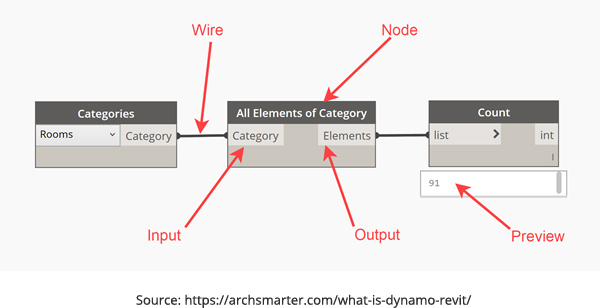
The program progresses in the form of a graphical flowchart, where data flows from one node to another through the network of wires to achieve the end result.
Dynamo is an Open Source Programming Tool that gives it an edge above other visual programming languages (VPL). An open source user community often introduces new concepts and ideas that support the gradual improvement of the tool and extend help through the forum. Users create, upload, and share packages through Dynamo Package Manager that may contain a single node or library of nodes. The packages like clockwork and data-shapes can solve specific problems of the users.
When integrated with Autodesk Revit, Dynamo solves modeling challenges in a smart and fast way. The library of nodes of the VPL gives access to the users, to select a specific node to perform a task, instead of coding. Dynamo gives direct access to the Revit API, where programming skills are not required. The mathematical tools of the dynamo, help in the easy evaluation of the building parameters. A project model can be easily developed, accessed, and edited with dynamo.
How Dynamo Integrates into Revit to Enhance BIM Workflow
One needs an open source version of Dynamo to integrate the tool with Revit. Dynamo is required to be launched in as an add-in in a dynamo supported version of Revit to make the necessary changes and modifications in the Revit file. These add-ins support in enhancing the workflow of the BIM projects.
The open source version of Dynamo can be downloaded and installed from DynamoBIM.org. After getting installed, it gets added to the Add-in tabs of Revit.

The tool needs to be properly installed to run inside Revit and provide users access to the packages or customized nodes. It is suggested to use dual monitors while using Dynamos.
Note that Dynamo is a node- based visual programming that allows the users to manipulate and use the Revit APIs through its nodes and wires to create customized functions.
Dynamo in Revit gets linked to the file and the page or view through which it is launched. When any changes are made to a Revit file in dynamo, they get updated to the page from which dynamo was launched.
In manual mode, the Run button gets grey in color and becomes dysfunctional, if you work in a different Revit file. While in Automatic mode, no changes will be made by dynamo if the user is on a file which is not connected to Dynamo or is not the launch page of Dynamo.
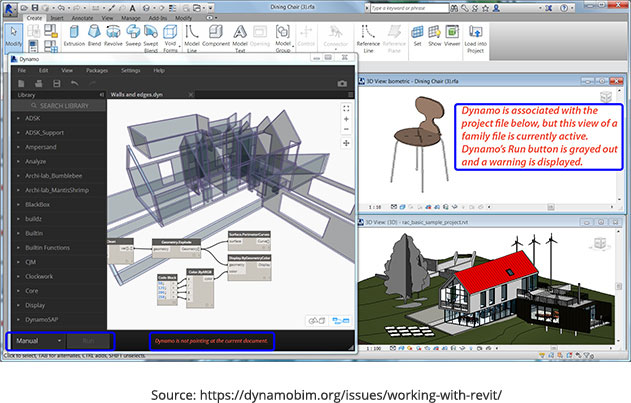
Benefits of Incorporating Dynamo
Easy to Automate the Repetitive Tasks
There are some tasks in Revit which are mundane and repetitive as you have to spend a number of hours to complete those. Automating these tasks through Dynamo helps in getting rid of these boring tasks and saves time to make better use of it.
Here is a list of some of the repetitive tasks you might come across while working in Revit.
- Creating a number of sheets
- Renumbering or renaming the series of sheets
- Rotating various columns on their axis
- Adding levels above a selected level
You can automate these tasks by creating tools for each in Dynamo. These tools can be accessed later with the use of Dynamo Player in Revit.
Example –
For instance, if you want to elevate a building by adding 40 levels to it, you can create a Dynamo script for it using the Dynamo Player. The updated Revit 2018.1 version includes a script called Add Levels above the selected Level by default in the Dynamo Player.
First, you need to open the Dynamo Player, then click on the properties icon which is next to the script play button.
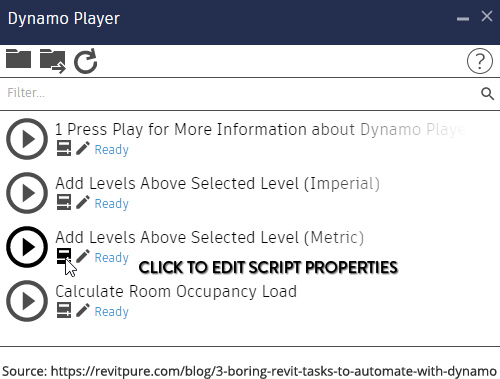
You can set the number of new levels we want to add and set the distance between each level. Then, select the level above which, new levels needs to be added.
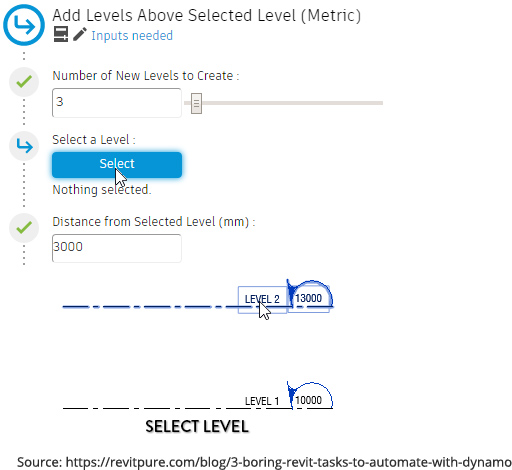
Finally, click on the play button of the Dynamo player to get the final result.
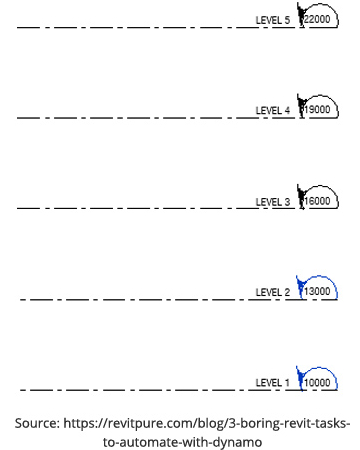
The whole script can be obtained by clicking the pen icon in the Dynamo Player. After taking the input from the user, a new sequence is created. The information is passed to create new levels and then output is generated.
Manage the Data of Revit Software with Dynamo
Using Dynamo, you can Extract building data from Revit, make the required changes, and write the data back in the Revit database.
In Dynamo, Revit Data can be selected in two ways, either, manually or automatically. The manual selection includes Families and Faces, whereas, Automatic Selection includes Revit Categories, Families, Elements, and used custom nodes. Automatic selection can be filtered by strings, numbers, or other data types.
The extracted data from Revit can be manipulated and changed in Dynamo as per your need or requirement. Now, data can be imported to Excel spreadsheet as well, as Dynamo has managed to create a two-way link between Revit and Excel. For example, you can create a graph to export the data from Revit to Excel, make the required changes in Excel, and then, create a graph again to import the data back in Revit.
Generate Multiple Design Options
Manual Modeling has come to an end with Dynamo. The Dynamo studio has the potential to create multiple design options when fueled with appropriate data. With Dynamo, the design rules can be encoded in a computational framework, which gives the advantage to create and explore multiple design options.

Case Study – 10 Alternative Designs in Just Four Hours Using Dynamo
As per the case study from Dynamo BIM, a construction leader of Nordic Region, MT Højgaard and Virtual Design and Construction (VDC) team used the Dynamo Studio to create and explore thousands of design options for the garage.
The VDC team created a design-rule including the parameters like elements, levels, lengths, number of spaces, structural standards, etc. Also, geometries were generated and reviewed by them to select the best alternative.
To estimate the cost of the selected alternatives, Dynamo was linked to Autodesk Revit, the BIM Software. Revit gave a high-quality visualization of the alternatives and with Project Fractal, deep insight of the cost was attained for each design.
Project Fractal is a cloud-based service and can read the design-variations in Dynamo. With these tools, the cost details of each alternative with specifications, like cost per element, and cost per garage space was obtained.
Dynamo Studio can demonstrate multiple geometries in real- time and saves time by automating the repetitive tasks.
Easy Assessment of Project Design Performance
During the design phase of a project, it is convenient to make changes, if a particular design is not going to perform as expected in real-life. Dynamo gives the users an advantage to evaluate the performance of a project in its design phase and make the required changes. You can simulate the building performance with Dynamo throughout its design phase to estimate its performance in real-life conditions.
Dynamo enables to create assessment tools on various parameters like standards of lightning, ventilation, temperature, energy consumption, and others to assess the performance of the project. Through this computational tool, it is easy to select the best design alternative which stands to meet ;the original targets of these parameters. Continuous performance measurement of a project in the design stage helps in on-time troubleshooting and saves time and money through these forecasts.
Multiplying the Power of Revit with Dynamo
The benefits of integrating Dynamo in Revit is reiterating the power of Dynamo. The computational design, open source community, automation, data management, graphical programming, ability to define customized logic and to make tools makes Dynamo one of the powerful VPL. When paired with Revit, Dynamo extends the power of Revit by bridging the workflow gaps and adding value to the project design with its numerous features. Now, creating a dynamic and effective model is no more difficult and time-consuming.
Combinedly, Revit and Dynamo empowers a company to make it powerful and expert in the market. In the AEC Industry, Dynamo has the potential to make a company more competitive and scale its business to a all new level.







